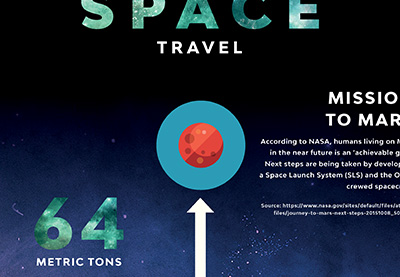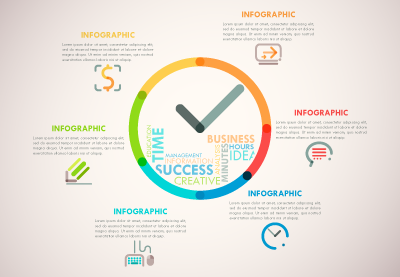An Interest In:
Web News this Week
- April 30, 2024
- April 29, 2024
- April 28, 2024
- April 27, 2024
- April 26, 2024
- April 25, 2024
- April 24, 2024
A Beginners Guide to Creating Infographics
Looking for a more compelling and interesting way to present information? An infographic template is an exciting way to visually convey data or statistics to viewers.
Infographics are perfect for integrating into reports and presentations, or as stand-alone designs for posters or social media.
In this article, we’ll look at how you can create your own infographic design templates, from which software to use to handy tips on how to create an infographic layout.
You can find a wide range of infographic templates on Envato Elements and GraphicRiver to help you make a quick start on creating your own infographic designs.

What Are Infographics?
Infographics are visual representations of data, information, or statistics. The main purpose of an infographic is communicative—to present information quickly and clearly in an easy-to-understand way.
As well as having a functional communicative purpose, infographics can also be beautifully designed, using a combination of color, graphics and typography to display information in a compelling and attractive format.

Looking for some beautiful infographic inspiration? Check out Information is Beautiful, by designer David McCandless, which explores the world of thoughtfully designed infographics.
When Should I Use Infographics?
Imagine you are presenting a topic to somebody who knows nothing or very little about that subject, and perhaps has little time on their hands. Would they choose to spend their limited time reading through a long document on the subject? Probably not.
Infographics are perhaps in part a response to the low attention span culture that has emerged over the last couple of decades with the birth of the internet and increased use of smartphones. People now have a huge number of things competing for their attention, so it’s become increasingly vital to get your point across quickly and concisely.
Infographic designers use a variety of techniques to draw attention from easily distracted eyes, such as pattern, vibrant color, engaging graphics, and visual hierarchy.

So any situation in which you want to communicate factual information quickly would be an appropriate context for an infographic. Some examples in the workplace might be pitch presentations or annual reports. Other common uses for infographics might be on social media (such as raising awareness of a not-for-profit cause on Facebook), or in print media, such as on posters designed for offices, colleges, or community halls.

The growing popularity of infographics over the last few years has led to an overload in use of infographics in contexts that are not always appropriate or necessary, however. Because infographics are designed to present information in a simplified, condensed format, they are not suitable for contexts in which the full scope of information is required.
So an infographic might not be the best choice for an academic paper or an audit report, for example. In these cases, depth and comprehension of data are more important than visual presentation.
How Do I Create an Infographic Template?
You can create infographics using a range of software, though programs which allow you to work with vector graphics, such as Adobe Illustrator or Adobe InDesign, tend to be best as they will allow you to scale the design without losing quality.
The workflow below gives you a good guide for drafting and creating your infographic, from deciding on your subject to exporting it for sharing with others.
1. Decide on the Subject of Your Infographic
It’s likely you already have a subject in mind for your infographic, but consider how this could be condensed or best presented to your audience. If intended for social media or posters, infographics tend to be only one page long, so you will need to approach your topic from an achievable angle.
For example, you might want to highlight gender inequality as an issue, but for a single infographic it might be better to narrow your scope. Highlighting a single aspect of the topic, such as the gender pay gap, will help you to create a stronger, more focussed design.
Infographics are fantastic tools for education. Use the medium to educate others about topics which are important to you or your business. Check out these educational infographic tutorials to make a start:

How to Create a Russia Infographic in Adobe InDesign

How to Create an Education Infographic in Adobe InDesign

How to Create a Space Travel Infographic in Adobe InDesign

How to Create an ‘Earth Day’ Plastic Pollution Infographic in Adobe InDesign

How to Create a Climate Change Infographic in Adobe InDesign
Want to highlight a charitable cause or raise awareness about an upcoming event? Infographics are the perfect media for communicating details about some of today’s pressing issues and topics. Be inspired by these motivational infographics:

How to Create an Infographic Design in Adobe InDesign

How to Create a Timeline Infographic for Black History Month in Illustrator

How to Create a Rainbow Road Infographic to Celebrate Pride Month
2. Decide What You Want to Highlight
When you’ve decided on the theme of your infographic, it’s time to gather your data. A variety of data formats, such as numeric statistics, facts and percentages, can be reimagined visually as charts, timelines, pull-outs, or maps.

When you have gathered a variety of data to use on your design, you should split the information into a hierarchy. Very important or especially memorable information should be given more space and prominence on the layout. Data that can be accumulated into charts might need more in-depth analysis from the viewer, so these should have a secondary priority on the design.
If you have a concise set of data, such as a list of percentage-based facts, consider whether it would be possible to convey this as one visual concept, such as in the example below.

3. Size Your Template Based on How You'll Be Sharing It
Infographics can be shared with an audience in a variety of ways. For print media, an infographic could be in poster format or included as part of a brochure or presentation.

If the infographic is to be shared online, it could be for a Facebook or Instagram post, or be part of a broad tableau of images on Pinterest.
Before you start designing your infographic, decide on the final intent of your design. If you’re hoping to share it both in print format and online, you may need to adapt the page size for each accordingly.
Check out these guides on finding the right size for printed flyers and posters, and sizing your designs for Instagram Stories:

Your Guide to Standard US and International Flyer and Poster Sizes

How to Create an Instagram Story Cover: Photoshop in 60 Seconds
4. Source or Create Graphics for Your Design
Once you’ve set up your canvas to the right size, you can start populating your layout with graphics.
Some designers will choose to create complete infographics from scratch, while others will use or adapt vector graphics to save time.
Icon and infographic element packs are indispensable tools for budding infographic designers. Look for themed packs of icons to source graphics that are uniquely suited to your design, or look to packs of charts and graphs to source ready-made graphic elements for your layout.


5. Create a Color Scheme for Your Design
Color should be a key feature of your infographic design. Not only can you use color to catch the eye, but thoughtfully applied color and pattern can be used to convey information more effectively.
From color-coding worrying statistics in red to highlighting trend patterns in bar charts, color can be an effective and low-effort way to make your design more effective and compelling.
Your chosen theme might guide your choice of color (for example, an eco-friendly green palette for environmental-themed infographics) or you might want to source some different color inspiration. Check out these tutorials to pick up some cool color ideas:

How to Create Five On-Trend ASE Color Palettes in Adobe Software

Creating Graphic Design and Illustration for Color Blind People
6. Format Typography on Your Design
Once you’ve assembled a range of graphics, charts and icons on your layout and applied an eye-catching color palette, you can start to think about the text content of your infographic template.
Most infographics will feature a large, prominent header, usually at the top of the layout. Then focus on creating a hierarchy of type across the design. Set prominent statistics and facts in the largest font size, followed by subtitles. Any longer sections of body text and captions should be set at the smallest size.
You might need to include unusual glyphs in your infographic text, such as currency symbols. To access a wider range of glyphs in Adobe InDesign, open up the Glyphs panel (Window > Type & Tables > Glyphs).
Clean sans serif fonts are usually the easiest to read online, and they suit the modern infographic format.
7. Export Your Infographic Template for Sharing
When you’ve finished designing your infographic, it’s time to share it with the world!
If you’re looking to print your design professionally, make sure to export your design as a press-quality PDF (in InDesign, go to File > Export and choose Adobe PDF [Print] from the Format menu).
For online sharing, exporting your infographic as a JPEG or PNG image with a 72 dpi resolution is usually the best option. Then all you need to do is upload your image and you’re ready to share your design.
Conclusion: Getting Started With Creating Infographic Templates
Infographics are a great way to present otherwise complex or even dull information in an exciting and engaging way. From informing colleagues about the business’s sales to raising awareness about social issues, infographics can have a huge range of interesting uses.
In this article, we’ve looked at a simple workflow for getting started with creating your own infographic designs, from sourcing vector graphics to creating an effective color palette.
Infographic layout templates certainly don’t have to be tricky to create. While they may look complicated, they can often be built using existing elements.
You can find a huge selection of infographic icons and templates on Envato Elements and GraphicRiver to help you make a confident start with designing your own infographic templates.
Looking for more infographic tips and tricks? Don’t miss these infographic tutorials:
Original Link: https://design.tutsplus.com/articles/a-beginners-guide-to-creating-infographics--cms-32938
TutsPlus - Design
 TutsPlus+ is a blog/Photoshop site made to house and showcase some of the best Photoshop tutorials around.
TutsPlus+ is a blog/Photoshop site made to house and showcase some of the best Photoshop tutorials around.More About this Source Visit TutsPlus - Design









